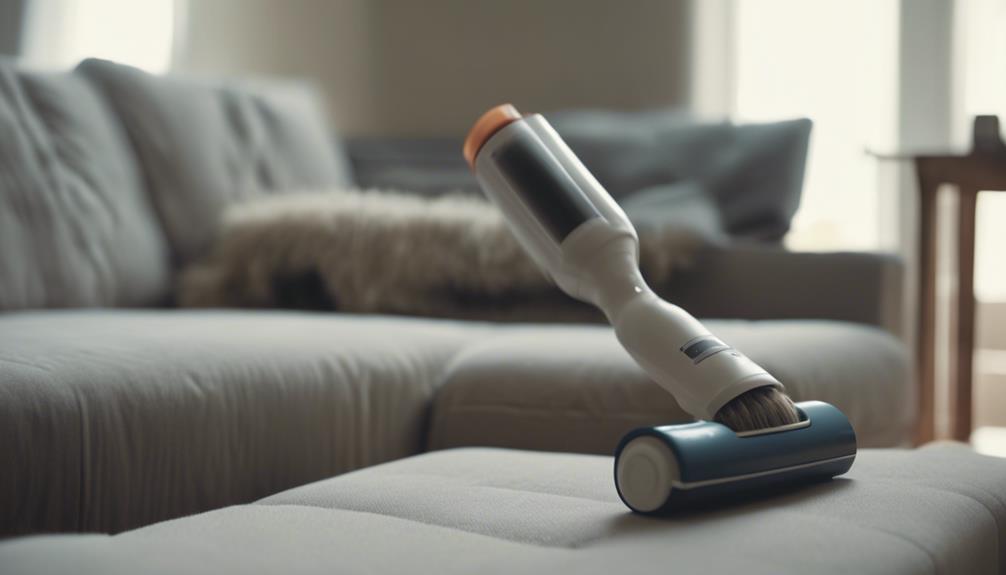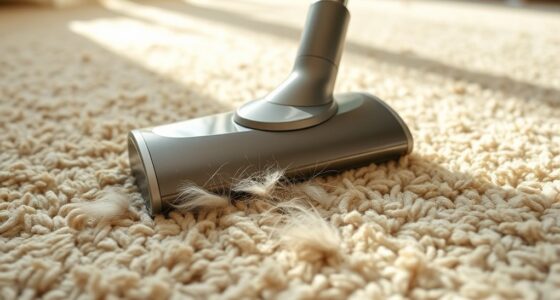Pet dander consists of tiny skin flakes shed by animals like cats and dogs, which stay airborne for hours and settle on surfaces. When you inhale this airborne dander, your immune system overreacts, causing symptoms like sneezing, itchy eyes, and congestion. Even hypoallergenic pets produce enough dander to trigger reactions. To better understand how to manage these triggers and reduce your symptoms, keep exploring effective cleaning and pet care strategies.
Key Takeaways
- Pet dander consists of tiny skin flakes shed by animals, small enough to stay airborne and trigger allergies.
- Airborne pet dander can cause immune reactions, leading to symptoms like sneezing, itchy eyes, and nasal congestion.
- Regular cleaning with HEPA filters and air purifiers reduces allergen buildup and airborne dander.
- Pet management strategies, such as grooming and creating pet-free zones, help minimize allergen exposure.
- Complete elimination of pet dander is impossible, but consistent precautions can significantly reduce allergy symptoms.

Have you ever noticed sneezing, itchy eyes, or a runny nose after spending time around pets? If so, you’re not alone. Pet dander, tiny skin flakes shed by animals like cats and dogs, is a common trigger for allergic reactions. Understanding how pet dander affects your body can help you take effective allergy prevention steps and minimize your symptoms.
Pet dander particles are so small they can stay airborne for hours, settling on furniture, clothing, and surfaces. When these particles become airborne, they can easily be inhaled, causing your immune system to overreact. This overreaction manifests as sneezing, nasal congestion, itchy or watery eyes, and sometimes even asthma symptoms. You might not realize it, but even pets that seem hypoallergenic can produce enough dander to trigger allergies in sensitive individuals.
To better manage your allergy symptoms, focusing on dander reduction techniques can make a considerable difference. Regular cleaning is vital—vacuum your home frequently with a HEPA filter vacuum cleaner, which traps tiny particles like pet dander effectively. Washing bedding, curtains, and pet accessories weekly also helps reduce allergen buildup. Air purifiers equipped with HEPA filters can improve indoor air quality by capturing airborne dander, creating a cleaner environment for allergy sufferers.
In addition to cleaning, establishing specific routines for allergy prevention is vital. Designate pet-free zones in your home, especially in bedrooms, to limit dander exposure where you rest. Bathing your pets regularly can greatly decrease the amount of dander they shed, but it’s vital to use pet-friendly shampoos and ensure thorough rinsing. Brushing your pets outdoors prevents dander from spreading inside your home and reduces the amount of skin flakes they shed.
Another effective approach involves managing your pet’s environment and behavior. Keep pets off furniture and beds to limit allergen transfer. Using washable covers on furniture can help contain dander and make cleaning easier. Regularly grooming your pets reduces loose skin flakes and minimizes the amount of dander circulating in your home.
Additionally, understanding the role of immune response in pet allergies can help you better anticipate and manage symptoms. Ultimately, combining these dander reduction techniques with allergy prevention strategies allows you to enjoy a cleaner, healthier living space. While it’s impossible to eliminate pet dander entirely, consistent effort can greatly decrease your exposure and make allergy symptoms more manageable. Recognizing triggers and maintaining a clean environment empowers you to enjoy the companionship of pets without constantly battling allergy discomfort.
Frequently Asked Questions
Can Pet Dander Cause Asthma Attacks?
Yes, pet dander can cause asthma attacks. The impact of pet dander on your respiratory system makes it a common allergy trigger. When you breathe in pet dander, your airways may become inflamed and narrowed, leading to difficulty breathing or an asthma attack. If you’re sensitive, reducing exposure and managing allergy symptoms can help prevent these reactions and keep your asthma under control.
Do All Pets Produce the Same Amount of Dander?
Not all pets produce the same amount of dander. Some, like cats with thick feline fur, shed more and release more allergens into the air. Birds with delicate feathers shed less dander but still impact allergy sufferers. You might find that your pet’s dander level varies based on breed, grooming, and environment. Whether it’s feline fur or bird feathers, understanding these differences helps you manage allergy symptoms better.
How Long Does Pet Dander Stay in the Air?
Pet dander can stay in the air for several hours, often up to 6 or more, especially in poorly ventilated spaces. To reduce this, you should use air filtration systems and vacuum regularly. Bathing your pet with a suitable pet shampoo helps minimize dander. Keeping your home clean and well-ventilated can markedly lower allergen levels, making it easier for you to breathe comfortably around your pet.
Are There Specific Breeds Less Likely to Trigger Allergies?
Did you know that approximately 10-20% of allergy sufferers find hypoallergenic breeds less triggering? You should consider breeds like the Poodle or Bichon Frise, known for dander reduction. These hypoallergenic breeds produce fewer allergens, making them better options if you want to enjoy a pet without constant allergy flare-ups. While no breed is completely allergen-free, choosing the right one can markedly reduce your allergy symptoms and improve your living environment.
Can Allergy Medications Completely Eliminate Pet Dander Reactions?
Allergy medications can markedly reduce your reactions to pet dander, but they can’t completely eliminate them. Their effectiveness varies from person to person, and some may still experience symptoms despite taking medications. To achieve better pet dander reduction, combine allergy meds with regular cleaning and grooming. You might also consider allergen-proof filters. While medications help manage symptoms, no single treatment guarantees total relief from pet dander reactions.
Conclusion
By understanding pet dander and its role in triggering allergies, you empower yourself to effectively manage your sensitivities. Recognize the risks, reduce dander buildup, and implement practical precautions to protect your health. Remember, awareness and action go hand in hand—so stay vigilant, keep your space clean, and create a comfortable, allergy-friendly environment. Ultimately, your proactive approach paves the path to peace, patience, and a healthier, happier harmony at home.









